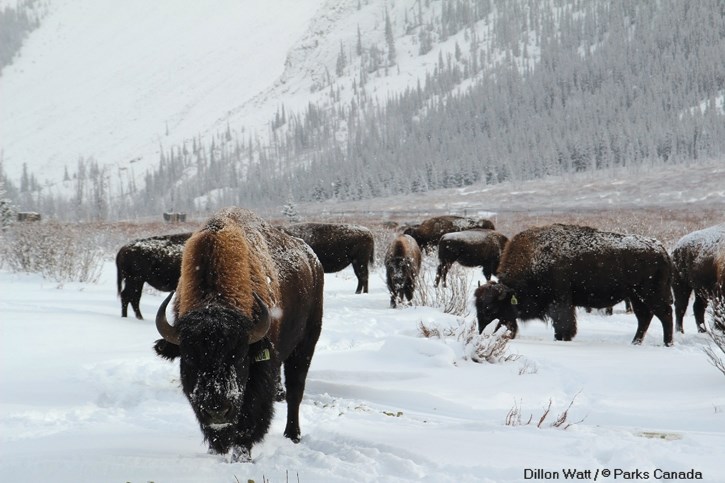More bison babies are on the way in Banff. On Tuesday (March 20), Parks Canada announced nine of 10 cows brought to the Panther Valley as part of Banff National Park's ambitious $6.6 million bison reintroduction program are pregnant.
More bison babies are on the way in Banff.
On Tuesday (March 20), Parks Canada announced nine of 10 cows brought to the Panther Valley as part of Banff National Park's ambitious $6.6 million bison reintroduction program are pregnant.
Officials say park veterinarians did pregnancy checks on the cows as they were fitting them with GPS collars, noting some of the calves may be born as early as May, with the rest expected throughout spring and summer.
"We're really excited," said Bill Hunt, resource conservation manager for Banff National Park. "Last year's calves had been bred by mature bulls, and so it's a bit surprising nine out of 10 cows were successfully bred by these younger bulls. We thought we might have half of that."
Bison had been absent from Banff's backcountry for more than 140 years before 10 pregnant cows and six bulls were moved from a disease-free herd at Elk Island National Park in February 2017.
They were placed in an 18-hectare fenced pasture in the Panther Valley, about 40 kilometres north of the Banff townsite - a move designed to anchor the animals to their new home.
Last spring, all 10 females gave birth and all calves - seven females and three males - survived their first year. In early summer, the herd was released into a larger, fenced summer pasture where they had more space to forage.
A staff member is watching and caring for the bison around the clock inside the fenced pasture, where they're also being fed.
If all the calves are born successfully, it could bring the herd's number to 35 animals.
Hunt cautioned that these are wild bison, so there's a chance some cows will not bring their calves to full term.
"It's unlikely to have 100 per cent success," he said. "We'll hope for the best, but it wouldn't be uncommon to lose one or two."
GPS collars were put on female bison and ear tag transmitters on last year's calves between Feb. 26 and March 6 in preparation for letting them into a larger, 1,200 square kilometre reintroduction zone in the Panther and Dormer valleys in July.
The bulls will be fitted with collars closer to the release date.
Bison will be kept in the area, which is approximately the size of Calgary, where there will be approximately eight kilometres of adjustable wildlife fencing in 15 different locations (Parks Canada does not want the herd wandering outside of the larger reintroduction zone onto provincial land where there may be killed, or to more developed areas of the national park).
Monitoring the satellite collars, Parks Canada will keep tabs on bison and herd, haze, or bait them as necessary to help steer their movements to encourage them to develop an affinity with their new home range.
"The real challenge will begin once we open the gates this summer," Hunt said.
In 2022, Parks Canada will assess whether to continue or abandon the project.
For thousands of years, plains bison roamed the plains of North America. Their numbers were as large as 30 million, but bison nearly went extinct in the 19th Century within a single human lifetime due to overhunting and slaughter.
As migratory grazers, bison wandered into the mountains here, but haven't been present in the wilds of Banff's backcountry more than 140 years, before the creation of Banff National Park in 1885.
